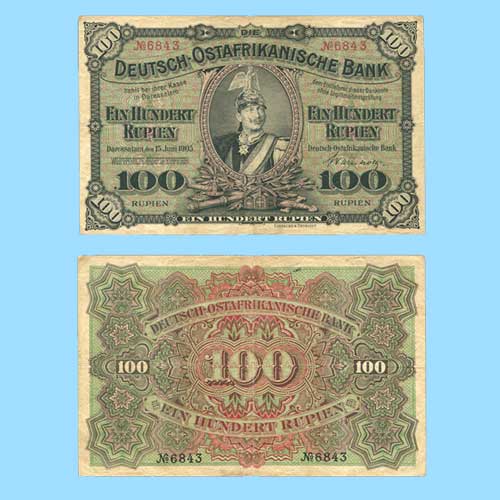German East Africa banknotes
2018-05-24 Thu
German East Africa (GEA) was a German colony in the African Great Lakes region, which included present-day Burundi, Rwanda, and the mainland part of Tanzania. Like other colonial powers, the Germans expanded their empire in the Africa Great Lakes region.Did you know, the Indian rupee was the dominant currency used along the East African coast during the second half of the 19th century? “Rupie” was the currency of GEA between 1890 and 1916. But it continued to be circulated in the Tanganyika Territory until 1920.
After 1890, the German East Africa Company acquired rights to mint coinage and issued rupies which were equivalent to the Indian and Zanzibar rupee. The Company retained its coinage rights even after the takeover of German East Africa by the government later in 1890. In 1904 the German government took over currency matters and established the “Ostafrikanische Bank”.
In 1905, the Deutsch-Ostafrikanische Bank introduced notes for 5, 10, 50, 100 and 500 Rupien. Between 1915 and 1917, emergency notes were issued in denominations of 1, 5, 10, 20, 50 and 200 Rupien.
The 100 Rupien 1905 banknote displayed in the image section depicts German Emperor Wilhelm II on the obverse.
Image Courtesy: Real Banknotes
Latest News
-
Science and Technology on Indian Postage Stamps-19
2025-12-26 FriSir Chandrasekhara Venkata Raman, widely recognized as C.V. Raman, was a distinguished Indian physic...
-
Science and Technology on Indian Postage Stamps-18
2025-12-23 TueIn the 1950s, the United States and the Soviet Union were engaged in a significant Competition known...
-
Silver Tanka of Malwa Sultan Nasir Shah
2025-12-22 MonIn silver, the #Malwa Sultan Nasir Shah (r. 906–916 AH / 1500–1511 CE) issued coins in two broad...
-
Science and Technology on Indian Postage Stamps-17
2025-12-22 MonArdaseer Cursetjee Wadia, a stalwart in the field of engineering, was born on 06 October 1808 in Sur...
-
Science and Technology on Indian Postage Stamps-16
2025-12-20 SatThe launch of India’s first combat warship, the frigate INS Nilgiri (F33), in 1968 marked a signif...

